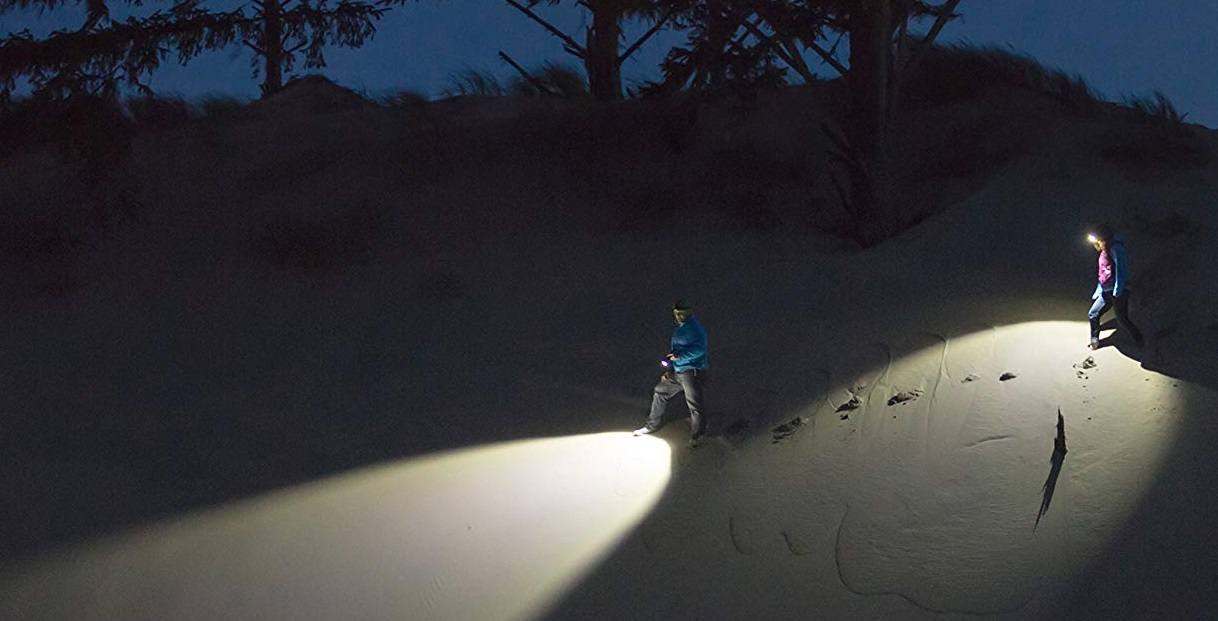Which headlamp is the best? To find out we took 28 top headlamps and put them through a gauntlet of side-by-side reviews. Each product was extensively field-tested. Find out which headlamps we loved, which to stuff in your rucksack for an epic backcountry trip, and which are best left on the store shelf.
Best Overall Headlamp: Coast HL7
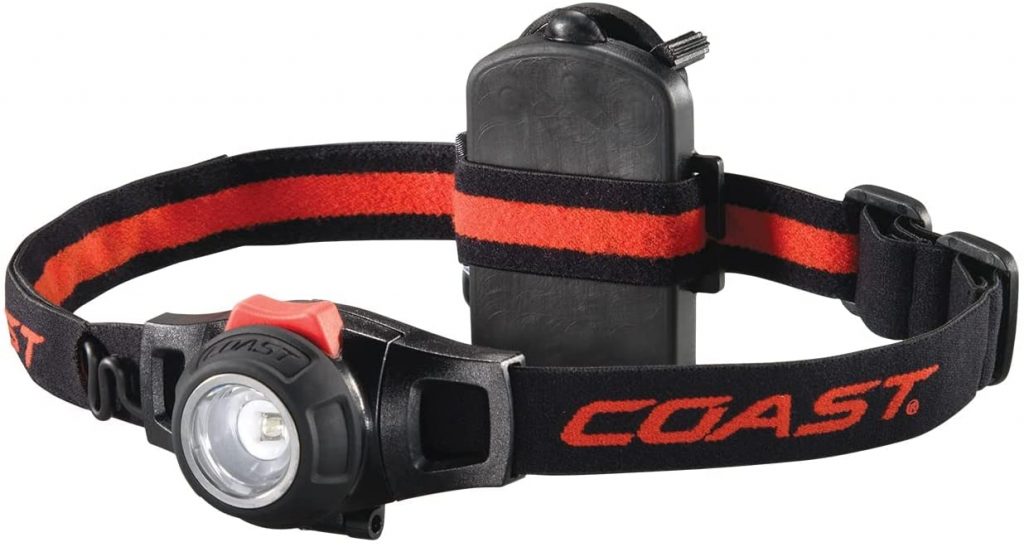
Selling at an amazingly low street price of $35 or less on Amazon, the Coast HL7 blew us away with a combination of a huge 131-meter beam distance, relatively light 4.5-ounce weight, and best-in-class floodlight optics. While not everyone loves the placement of the battery pack in the back, that design approach does make the light more balanced on the head. The Coast’s beam distance and high scores in trail finding and close proximity make it a compelling price-per-performance value relative to other popular lights selling at a similar or higher price, such as the $55 Petzl Tikka XP, the $40 Black Diamond Spot, or the $50 Princeton Tec Vizz. While the battery life is not great if you run it at full power, you can either turn the brightness down when you don’t need full beam and/or carry an extra 3 AAA batteries, which weigh only 1.2 ounces, to double the 3.4 hours high-mode life.
Best Rechargeable: Black Diamond ReVolt
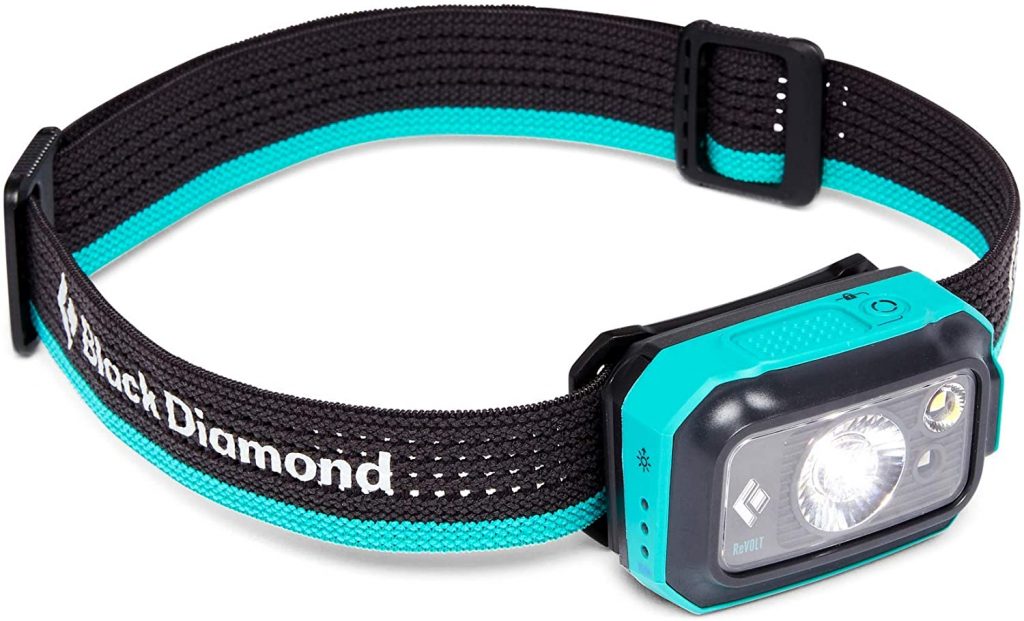
We’re convinced that the future of lighting lies in rechargeables, and we are excited to see the growing lineup of products that shun the traditional AA or AAA alkaline batteries for USB rechargeable alternatives.
The Black Diamond ReVolt is our choice of these state-of-the-art lights due to its combination of performance, lightweight (3.7 oz), and good price (under $60). While the ReVolt was not the best in any of our tests, it excels in everything, except brightness. And, even in brightness, it’s no slouch, casting a very useful 56-meter beam (about 180 feet). Battery life is where this light really excels, especially for a rechargeable. As the batteries drain, we found beam distance in high mode dropped steadily from 56 meters to about 20 meters over the first five hours (not bad compared to competing lights) and then maintained a pretty constant 20-meter beam distance for the next 12 hours. Based on the ANSI standard, the ReVolt scored an impressive 10.6 hours run-time, and that earned it the top rating score in battery life, 9 of 10. We successfully tested USB recharging of the ReVolt from wall adapters, laptops, and from portable solar panels.
The ReVolt accepts alkaline AAA batteries, providing added flexibility and an excellent backup option. If you hate buying (and throwing away) batteries, travel to remote regions where battery replacement is impractical, or use your light at least weekly, you’ll find the ReVolt to be a solution that will pay for itself in reduced battery costs and will provide excellent performance at the same time.
Best Budget Lamp: Petzl Tikkina
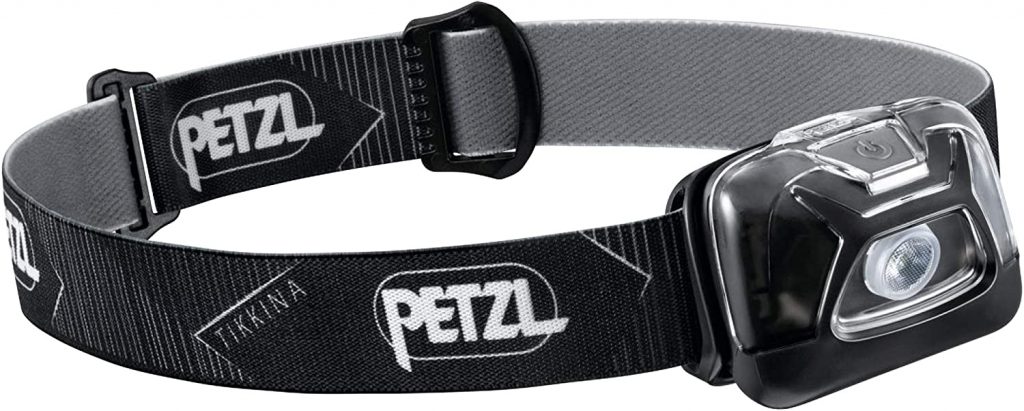
For now, the quality gap between low-end lights sold at outdoor retailers, such as the Petzl Tikkina or the Black Diamond Gizmo, and the entry-level lights you’d find at Home Depot is just too big. But, each year competitive offerings at the low-end improve. Today, with the Energizer 3 LED available for just $12, we find it impossible to ignore the great value it offers for those looking for basic utility lighting, though it still could not match the inexpensive offering from Petzl. In 2019, with the Tikkina being widely available for less than $20, and its batteries lasting longer than most other lights we tested, our choice for Best Buy was an easy one. In the future, we expect technology to trickle down and construction quality to only improve. It will not surprise us when excellent LED lights are widely available for less than $10.
Top pick for ultralight: Petzl e+LITE

If you keep it in low mode, the battery holds up a long time. And, if you end up in an emergency situation, flip it to the flashing red LED for an emergency beacon that lasts for days. You might think the retractable zip-line headband would be uncomfortable, but due to the e+LITE’s featherweight, we found that it works well. The e+LITE is robust with solid construction and is waterproof up to one meter. It’s perfect for ultralight backpackers, or anyone who values small size and/or lightweight.
Top pick for runners: Black Diamond Sprinter
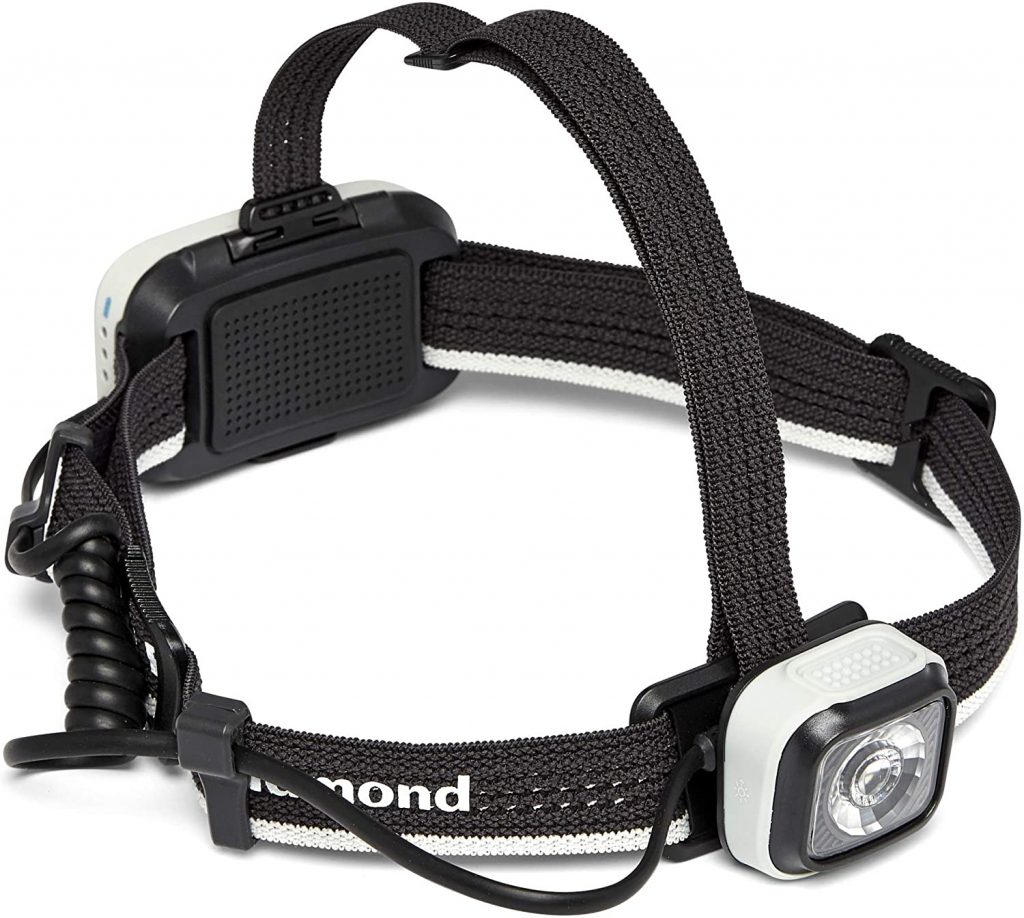
This isn’t the brightest lamp, and its battery doesn’t last as long as other options. But the battery is rechargeable. The construction fits well on a bouncing runner’s head, and the light is constructed such that you can point a white light forward for illuminating your way and point a red light backward for safety visibility. In short, this light is purpose-built for road running in the dark. As such, it excels.
How to Choose The Best Headlamp for Your Needs
The ability to leave your hands free, and easily direct light with head movements, have made headlamps increasingly popular. After studying more than 90 products, and putting half of those lights through at least one intensive six-month test, we are left with more than a little bit of skepticism about the marketing ethics of manufacturers. Our first rule for buying is this: manufacturers’ specs are misleading, most especially with regard to battery life.
Lies, Damned Lies, and Marketing
Here’s what you should know before you get all giddy reading the manufacturer’s specs and say something naive like: “Hey Skippy, this shines a 50-meter beam for over 150 hours!” Umm, how can we break this to you? It’s a lie.
While the manufacturers’ marketing department might crack an evil smile at the prospect of fooling millions of consumers into believing that their claimed brightness is maintained throughout the claimed run-time, the engineers designing these lights know that idea is wildly disconnected from the reality of beam distance performance. We think misleading consumers in this way is wrong and it needs to be stopped. We hope to help do just that by literally and figuratively shedding light on the subject.
Most manufacturers report three major specifications. They will describe the lumens in their lights, the distance a beam will go in high mode, and the amount of time the batteries will burn in that high mode. They may report other stats, but these three predominate.
Lumens Are for Light Bulbs
Pretty much every headlamp includes a spec for lumens, but we ignore this spec. Why? Because lumens are a measure of light energy in any direction. This is a good way to spec a light bulb, but often misleading for estimating the quality of a focused beam.
Beam Distance Specs From Manufacturers Can Be Misleading
- The cited beam distance is a maximum amount that only applies to the initial minutes of use with fresh batteries. Beam distance rapidly degrades within a remarkably short time.
- If the beam is too narrow, it may shine a great distance but be practically worthless in the field. A narrow beam is frustrating in practice; it’s like looking down a tunnel.
- The specs on packaging are based on manufacturer claims, not independent lab test results. We concluded that most manufacturers over-estimate their beam distance, but generally not disturbingly so.
Battery Run-time Specs Are Misleading
The high-output battery run-time is given alongside a beam distance spec (e.g. High: 100 meters beam distance, 80 hours run-time). Most consumers logically conclude that they will be able to see that beam distance for the specified run-time (i.e. “In High mode, I will be able to shine a beam distance of 100 meters for 80 hours”). The truth is far from that since beam distance degrades rapidly as the batteries drain.
Most manufacturers have shunned the ANSI standard for battery run-time measurement and instead allow the “battery run-time” clock to keep going until the light gets to the dim light of a candle placed two meters away (0.25 lux). This results in huge, and misleading, battery run-time specs that aren’t anywhere close to what most consumers would consider high-output light levels.
The variance between our experience and manufacturers’ claims on high-mode battery run-times were nothing less than appalling. On average, manufacturers’ claimed high mode battery run-times were 4x higher than our actual measurements of high mode battery run times using the ANSI FL-1 standard. This is a huge variance. In one case, the variance was 38x. The most popular Black Diamond and Petzl lamps were about 10x overstated when compared to our own experience. We think that is nasty.
Umm, Guys, There Is an ANSI Standard Here…
In 2009, the American National Standards Institute (ANSI) developed an industry-standard specification called the FL1 Flashlight basic performance standard. It provides standards for measurements of light output, beam distance, battery run-time, water resistance, and other claims and was developed with input from about a dozen top manufacturers of flashlights, headlights, and major retailers, including REI.
As reported by REI, who was on the ANSI FL1 committee, the manufacturers decided to reject the ANSI standard for battery run-time they had just taken part in the development and created yet another way of calculating battery run-time that we consider to be self-serving and very deceptive to consumers.
We Did Our Own Tests
Exasperated with manufacturers’ wild claims for battery run-times, we measured battery run-time ourselves using a data logging light meter and the ANSI standard as our guide. We believe our measurements, based on the ANSI FL1 standard, provide a much more realistic estimate of effective “high mode” run-time, and better fits consumer expectations of high-output performance.
Types of Lights
There was a time not long ago when there were a lot of different types of lights, many using different bulbs to achieve brighter light (incandescent, halogen, LED). In today’s market, every lamp we tested uses LED lights due to their extraordinary brightness and low-energy requirements. Today, there are really only four major feature varieties:
Spotlight mode – many products include specific bright LEDs and optics that focus the light in a beam best suited for looking at a distance. These spotlight beams shine brighter but narrower. This is the perfect light setting for viewing objects in the distance or for a hiker attempting to navigate a vaguely defined trail. Most lamps with a spot mode also include a separate wide flood mode for close proximity use.
Close proximity floodlight mode – a low-intensity floodlight casting a wide beam with even lighting is ideal for working around the campsite, in the tent, or in most household situations. The lower light level means the battery run-time is dramatically extended, and the reduced brightness means you won’t be blinding your campsite mates every time you look at them.
Red light – coveted by star-gazers and hunters, a red LED is also the most efficient in terms of battery life. Stargazers love a red light because it allows you to see reasonably well, but it doesn’t screw up your night vision. Hunters love a red light (or blue or green too) because animals’ eyes don’t see it, and thus you retain your camouflage. Red light can also be valuable in a search-and-rescue situation since a flashing red strobe is visible at great distances, yet it will last longer in terms of battery run-time than any other mode.
Rechargeable battery – rechargeable lights are clearly the future, as batteries are expensive and the cost of rechargeables continues to decline. Today, the return-on-investment is questionable for most of us (at $1 per alkaline battery), since we don’t churn through enough batteries to justify the approximately $20-$50 higher initial cost of rechargeable models (i.e. you’d need to buy 20-50 replacement batteries to break even). But, for those who use a light at least weekly, a rechargeable light is a smart investment that should pay for itself within a year or two.
How We Chose
We used a combination of testing techniques, both hands-on field tests and lab tests using industrial light meters, to rate each product on six different performance metrics. Below we’ll summarize each rating metric and the products which performed best and worst.
Trail Finding
The best lights in our trail finding review are the Petzl NAO, the Black Diamond Icon, and Fenix HP25. Of these, the NAO was a standout, offering awesome clarity and a bright, evenly lit beam. The Fenix light beam is more narrow but shines the furthest.
While it’s great to see incredibly great distances with the Fenix, some prefer the NAO’s wider beam when walking most sections of the trail. Trail walking also highlighted the NAO’s unique Reactive mode, in which the beam automatically gets brighter when you look into the distance and dims to save batteries when you look at objects closer. Reactive is an innovative feature Petzl is starting to roll out on other lights such as the recently released Petzl Tikka RXP, and we found it worked perfectly on the trail, getting bright when we peered into the distance, and adjusting to just the right light level for hiking when we looked at the trail just steps ahead.
It is important to note that these same high-performing lights also suffered from poor battery life in their high output mode. Only the Icon lasted more than 9 hours based on the ANSI standard, and the NAO only 2 hours.
When you consider battery life and trail finding together, then the best performer was slightly less bright than the top trail lights, but with significantly improved battery run-time: the Black Diamond ReVolt. The ReVolt can shine an evenly lit beam far down the trail for over 10 hours. Additionally, you can recharge it and do it all again the next night.
Brightness
We found the absolutely brightest light to be the Fenix HP25. The Fenix throws a long, narrow beam more than 22% farther than the next strongest light. With such an authoritative victory in brightness, the Fenix won our Top Pick award. The next in line, the Coast HL7, throws a wider beam 131 meters. Neither lasted four hours in their highest output mode, which is disappointing, but if you need distance, they are unmatched.
Close Proximity
For closer distances light performance, the best lights are the Zebralight H52, Nitecore HC50, and the Coast HL7. All three scored great in this category and offer what we consider to be near-perfect close-proximity lighting around the campsite with a wide, evenly lit beam.
Further adding utility, all three offer variable brightness so you easily can set the level just where you want it.
Additionally, especially around other users and light sources (like a campfire), the Reactive Lighting technology in the Petzl Tikka RXP and NAO gave us trouble. The light is adjusted based on what the sensors deem necessary. The sensors are confused by other light sources and the light flickers annoyingly. The Reactive technology can be turned off, but it contributes to a pretty expensive initial purchase price.
Battery Life
For high-mode lighting, We granted an overall battery life score based on the light performance, the availability of a locking switch, and high-mode brightness. (Brighter lights burn batteries faster than dimmer ones, all things equal. Brighter lights also usually have lower modes, so using a light at a lower percentage of its max will result in longer burn times than our coffin test suggests.) If the light comes on inadvertently, it can burn all your batteries before you even get a chance to use it.
The best lamp on battery life was the Black Diamond ReVolt which was unique in offering an excellent rechargeable battery. As you can see in this comparison of the Petzl Tikka RXP and the Black Diamond ReVolt, the ReVolt offers reduced brightness, but with the benefit of much much longer run-time (as well as much lower initial cost). For many people, the ReVolt offers a nice balance of good-enough brightness with excellent battery life. It is for this balance of performance that we gave it our Editors’ Choice award.
The Black Diamond Icon also deserves honorable mention for battery run-time because it had the best battery life of any light we tested offering greater than a 75-meter beam distance (about 250 feet). While a handful of lights could shine a beam further, they died out much more quickly, as can be seen in this comparison of the Icon versus the Editors’ Choice Coast HL7. The Icon was unique in being able to provide a reasonable distance beam all night (9.4 hours in our ANSI standard test). In its highly regarded low-light mode, the Icon will shine for many days.
One of the worst-performing lights in terms of battery run-time was the Petzl NAO. It is not surprising that the brightest lights gave out the quickest, and to be fair, we need to note that the NAO dominated our trail finding test (9/10 rating) due to its stellar combination of super-bright light, wide and evenly lit beam, and nearly perfect optics. While the battery held up, we loved the NAO. But, that love affair lasted only about 75 minutes.
Ease of Use
The Black Diamond Gizmo is the easiest to use light in our list. It offers a very simple and intuitive single button to turn it on and off. Anyone would be able to figure it out and master it immediately.
The Nitecore HC50 is the worst with the lowest score of 3 of 10. Initially, we were delivered a product that wouldn’t turn on at all. We never got that one to work. We purchased a new one and, while it did indeed work, we never did feel we figured out all the nuances and features of this beefy product.
Key Accessories
If you are planning to be away from a power source for many days, consider a Solar Charger such as the Instapark Mercury 10 or Poweradd Apollo 3 to recharge your headlamp. Another option would be an External Battery.
Some headlamps, like the Black Diamond Icon, offer rechargeable kit options. The Black Diamond NRG Rechargeable Battery Kit is a great battery pack that allows for extended use without the need for buying a lot of extra batteries.

